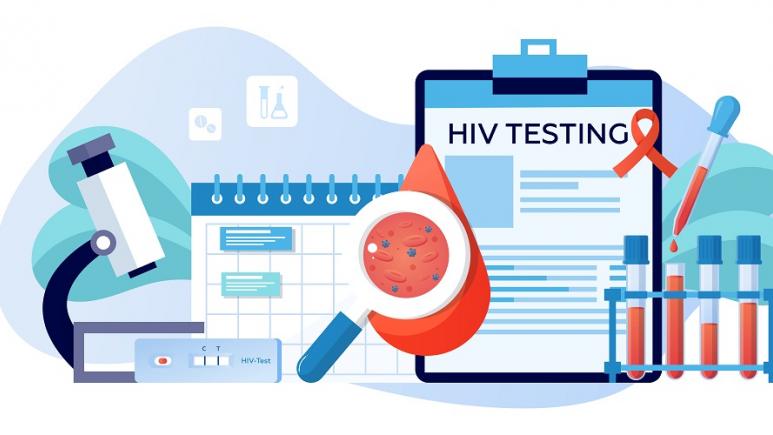HIV: combating treatment resistance more effectively
The treatment of HIV infection entails the use of different classes of antiretroviral (ARV) drugs to prevent the virus from multiplying in the body. Combination ART includes nucleoside reverse transcriptase inhibitors (NRTIs), the first class of ARVs to be marketed in 1987, and non-nucleoside reverse transcriptase inhibitors (NNRTIs), which appeared 10 years later.
Since 2019, in response to the increase in HIV resistance to ART - and more specifically to NNRTIs - the WHO has recommended dolutegravir as first- and second-line treatment. This new generation integrase inhibitor, which replaces NNRTIs, is prescribed in combination with tenofovir or zidovudine (NRTIs).
Despite a general increase in resistance, data show different situations according to countries and populations. The evolution of ART resistance is currently monitored through surveys and research studies due to the complexity and cost, to date, of resistance testing.
Adapting treatment according to observed resistance
"So, there were no reliable data on ART resistance in Mozambique, especially outside of the capital Maputo, nor information on resistance in patients treated with first-line tenofovir, notes Valentina Carnimeo, epidemiologist at Epicentre. In 2017, with MSF, we decided to do a situational analysis in Maputo and Tete, a more rural district in the north of the country." The objective was to assess acquired resistance to ART in treated patients, as well as in so-called naive people (i.e., those who have never taken anti-HIV therapy) or among patients restarting ART after an interruption of more than three months.
The first finding from this study, published in JAC Antimicrob Resist, is that less than 10% of patients in Maputo and about 16% in Tete were experiencing virological failure. "This rate, which is lower than expected, can be explained by the deployment of routine viral load tests in these regions, thanks to MSF's support over the past few years," says Valentina Carnimeo. Drug-resistance genotyping, on the other hand, carried out in patients with virological failure, shows that 90% have developed resistance to at least one of the most commonly used molecules during ARV treatment. In addition, double resistance to tenofovir/lamivudine – two molecules prescribed in combination with dolutegravir as a new first-line treatment – affects more than half of the people experiencing treatment failure.
As for the rates of resistance before treatment, or three months after its suspension, the results of the study are alarming with 17% in urban areas and 31% in rural areas. "These rates are well above the WHO alert threshold of 10%," says Valentina Carnimeo. In addition, high resistance to efavirenz, the ARV prescribed as an alternative to dolutegravir for women of childbearing age, due to the very low, but existing, risk of fetal malformation associated with this treatment, was observed.
While first-line dolutegravir should be offered immediately to all patients starting ART and to those previously exposed to anti-HIV therapies, this switch should be accompanied by viral load assessment and drug-resistance genotyping.
"In view of our results on tenofovir and lamivudine resistance among treatment-experienced patients, the effectiveness of the new first-line ART could potentially be reduced in half of these patients in Maputo (52.8%) and two-thirds of those in the rural area of Tete (66.7%)," concludes the epidemiologist.
Promptly switching to an effective treatment for patients with advanced HIV
Another study, mixing quantitative and qualitative methods (mixed methods), was conducted by Claire Bossard, an epidemiologist based in South Africa with Epicentre. The recently published quantitative component of the study (highlights the need to improve access to viral load testing and drug-resistance genotyping.
"In the two MSF-supported hospitals where we conducted the study, in Kinshasa, Democratic Republic of Congo (DRC) and in Homa Bay, Kenya, 71% of patients in the DRC and 37% in Kenya had a high viral load (i.e., greater than or equal to 1,000 copies/ml), and of these, 73% had dual resistance to NRTIs and NNRTIs," explains Claire Bossard. Treatment interruptions of more than 48 hours in the last six months were reported by 57% of patients in the DRC and 42% in Kenya. Nearly half of the patients also had low blood levels of tenofovir, indicating suboptimal treatment uptake.
"Our study showed that in three-fourths of patients hospitalised with advanced HIV, two of the three molecules of their ART were ineffective, which means that these patients were treated with functional monotherapy," explains Claire Bossard.
In view of the resistance rates revealed by the study, a change of treatment should be considered from the initial detection of high viremia in patients with a CD4 count ≤350 cells/ml or when viral load is not available prior to discharge from the hospital for those with CD4 counts ≤100 cells/ml. These results contributed to an update of the clinical guidelines for HIV prevention, treatment, and care by the WHO (1). “Mortality in these hospitals is around 20-30%," continues Claire Bossard, "and post-hospital mortality, although more difficult to measure, is also considerable. It is vital to accelerate the immune reconstitution of these patients to improve their chances of survival, while of course continuing activities to support patient compliance and psychosocial support.”
Patients were also interviewed individually as part of the qualitative study to better understand their experience with diagnosis, treatment, and hospitalisation, and to trace their care pathways, with the aim of improving their medical care. (2)
While viral load and resistance testing is the best way, to date, to determine whether HIV treatments are effective, many patients still do not have access to these tests or the results are not available during during a patient's visit to the hospital, reducing the effectiveness of treatment approaches.
- Updated WHO recommendations on HIV treatment monitoring in March 2021
- These results will be the subject of a forthcoming publication : Slipping through the cracks: a qualitative study to explore pathways of HIV care and treatment amongst hospitalised patients with advanced HIV in Kenya and the Democratic Republic of the Congo.Rose Burnsa*, Emilie Venablesb,c, Lilian Odhochd, Lilian Kochollae, Stephen Wanjalad, Gisele Mucinyaf,Claire Bossarda, Alison Wringeg






